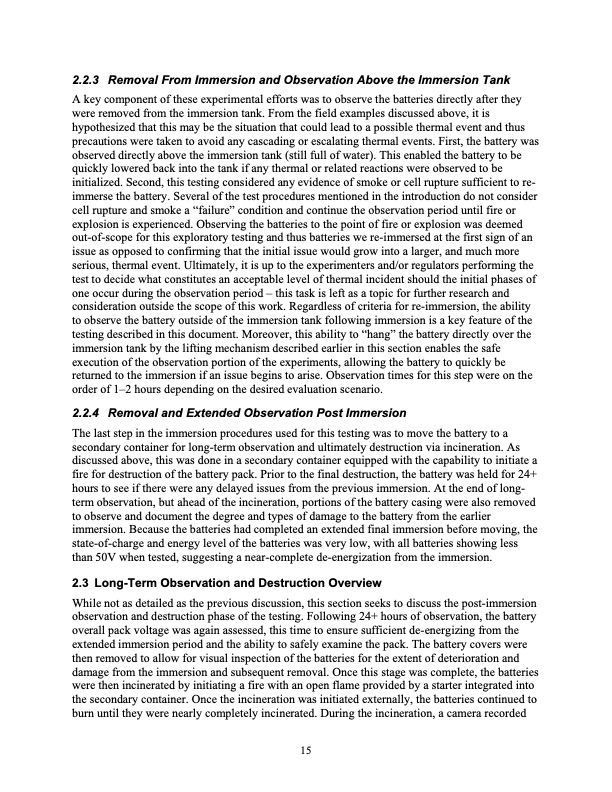
PDF Publication Title:
Text from PDF Page: 019
2.2.3 Removal From Immersion and Observation Above the Immersion Tank A key component of these experimental efforts was to observe the batteries directly after they were removed from the immersion tank. From the field examples discussed above, it is hypothesized that this may be the situation that could lead to a possible thermal event and thus precautions were taken to avoid any cascading or escalating thermal events. First, the battery was observed directly above the immersion tank (still full of water). This enabled the battery to be quickly lowered back into the tank if any thermal or related reactions were observed to be initialized. Second, this testing considered any evidence of smoke or cell rupture sufficient to re- immerse the battery. Several of the test procedures mentioned in the introduction do not consider cell rupture and smoke a “failure” condition and continue the observation period until fire or explosion is experienced. Observing the batteries to the point of fire or explosion was deemed out-of-scope for this exploratory testing and thus batteries we re-immersed at the first sign of an issue as opposed to confirming that the initial issue would grow into a larger, and much more serious, thermal event. Ultimately, it is up to the experimenters and/or regulators performing the test to decide what constitutes an acceptable level of thermal incident should the initial phases of one occur during the observation period – this task is left as a topic for further research and consideration outside the scope of this work. Regardless of criteria for re-immersion, the ability to observe the battery outside of the immersion tank following immersion is a key feature of the testing described in this document. Moreover, this ability to “hang” the battery directly over the immersion tank by the lifting mechanism described earlier in this section enables the safe execution of the observation portion of the experiments, allowing the battery to quickly be returned to the immersion if an issue begins to arise. Observation times for this step were on the order of 1–2 hours depending on the desired evaluation scenario. 2.2.4 Removal and Extended Observation Post Immersion The last step in the immersion procedures used for this testing was to move the battery to a secondary container for long-term observation and ultimately destruction via incineration. As discussed above, this was done in a secondary container equipped with the capability to initiate a fire for destruction of the battery pack. Prior to the final destruction, the battery was held for 24+ hours to see if there were any delayed issues from the previous immersion. At the end of long- term observation, but ahead of the incineration, portions of the battery casing were also removed to observe and document the degree and types of damage to the battery from the earlier immersion. Because the batteries had completed an extended final immersion before moving, the state-of-charge and energy level of the batteries was very low, with all batteries showing less than 50V when tested, suggesting a near-complete de-energization from the immersion. 2.3 Long-Term Observation and Destruction Overview While not as detailed as the previous discussion, this section seeks to discuss the post-immersion observation and destruction phase of the testing. Following 24+ hours of observation, the battery overall pack voltage was again assessed, this time to ensure sufficient de-energizing from the extended immersion period and the ability to safely examine the pack. The battery covers were then removed to allow for visual inspection of the batteries for the extent of deterioration and damage from the immersion and subsequent removal. Once this stage was complete, the batteries were then incinerated by initiating a fire with an open flame provided by a starter integrated into the secondary container. Once the incineration was initiated externally, the batteries continued to burn until they were nearly completely incinerated. During the incineration, a camera recorded 15PDF Image | Li-Ion Battery Pack Immersion Exploratory Investigation

PDF Search Title:
Li-Ion Battery Pack Immersion Exploratory InvestigationOriginal File Name Searched:
dot_57013_DS1.pdfDIY PDF Search: Google It | Yahoo | Bing
Product and Development Focus for Salgenx
Redox Flow Battery Technology: With the advent of the new USA tax credits for producing and selling batteries ($35/kW) we are focussing on a simple flow battery using shipping containers as the modular electrolyte storage units with tax credits up to $140,000 per system. Our main focus is on the salt battery. This battery can be used for both thermal and electrical storage applications. We call it the Cogeneration Battery or Cogen Battery. One project is converting salt (brine) based water conditioners to simultaneously produce power. In addition, there are many opportunities to extract Lithium from brine (salt lakes, groundwater, and producer water).Salt water or brine are huge sources for lithium. Most of the worlds lithium is acquired from a brine source. It's even in seawater in a low concentration. Brine is also a byproduct of huge powerplants, which can now use that as an electrolyte and a huge flow battery (which allows storage at the source).We welcome any business and equipment inquiries, as well as licensing our flow battery manufacturing.| CONTACT TEL: 608-238-6001 Email: greg@salgenx.com | RSS | AMP |